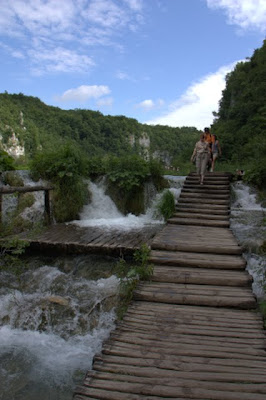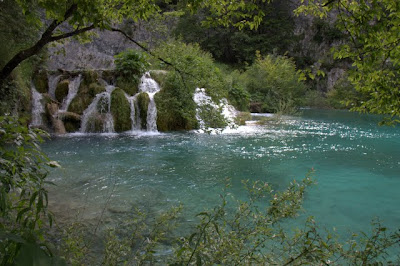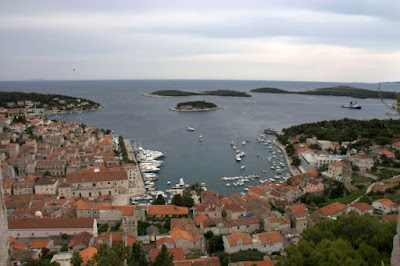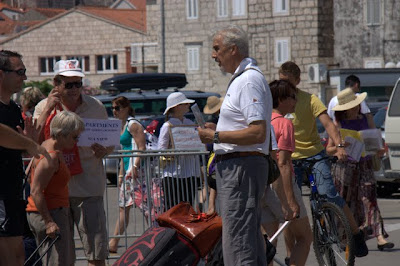Kids these days…
The promenade in Split was the site of one of the most bizarre things we have seen on this trip: the Dan Drzavnosti Little Girl Talent Show. Now, I have no idea who this Dan Drzavnosti is, or what the name of this spectacle was, but his name was plastered all over the stage. We saw a crowd gathering around a stage, and a little bored, we went to check it out.
What we saw was who we assumed was this Dan person singing that uno, dos, tres song in a super flat baritone, while extremely young girls bounced around behind him as he sang, “You know I want you…” Dan didn’t look much older than the girls themselves.
The talent show, if that is what it was, was like a train wreck. Each song got worse and worse, yet we didn’t turn away. There was a young Gwen Stefani, full of sass, singing Hollerback Girl at the top of her lungs, even though she couldn’t have been more than eight.
There was a pint-size rapper, leading his posse with hair that only could have resulted from sticking their fingers in electrical sockets through a rendition of Black Eyed Peas’ song, Tonight’s the Night.
There was a Lady Gaga, singing Bad Romance with a large hair piece and all of the drama her 8? 9? 10? (at most) self could muster.
Then it really got out of control. The next girl got up on stage. She was – maybe – 13.
When she started singing about her lovely lady lumps and do you want the junk in her trunk, I couldn’t take anymore. Doesn’t ANYONE think this is really odd? These girls are so young! Judging by the people cheering by the stage, I guess not.
As I prepared this post, I decided to find out who this Dan Drzavnosti is once and for all. It turns out that Dan Drzavnosti is not a person, but the name of Croatia’s Statehood Day. So apparently this was for a state holiday celebration!
Water wonderland: Plitvice National Park
Our last stop in Croatia was a visit to Plitvice National Park. Apparently, some buses stop there, but from what I read on the internet, taking a bus could be complicated and may involve flagging one down on the side of the road in order to go home. This sounded like more trouble than it was worth, so when we saw an opportunity to rent a super sweet Fiat again for under $40, we jumped at the chance. (Of course, this doesn’t count tolls or gas. One problem with budget cars is they are usually gas guzzlers). Turns out this time, the Fiat was not even made in this decade. And when it was made, it had to be the cheapiest, crappiest car one could buy. Sean: This doesn’t even have power steering! Amy: What does it mean to have power steering?
Plitvice is one of Croatia’s national parks located about 2 hours from Zagreb. It has 16 different lakes, all connected by tons of waterfalls. If we thought the water was turquoise in Slovenia, that is just because we hadn’t seen Plitivice yet. Apparently the lime content in the lakes colors the water various shades of blues and greens. Plitvice is the type of place better explained in pictures than in words, so without further ado:
If you go, consider going to the park late in the day after the tours leave. It only took us about 2 1/2 hours to go through the course that was supposed to take 3 to 4 hours. We also spent about another hour in the park walking up above. The park closes at 7:00, so going around 3:00 or 4:00 will give you plenty of time without most of the crowds.
Tracing Roots
Sean apparently looks Croatian. This was told to us twice. The first time it was by a Croatian man at the table next to us at a restaurant in Split, who shared his very strong wine with Sean. He studied Sean very carefully before he pronounced that Sean had a Croatian head. Sean’s Croatian looks were confirmed in a separate instance by the sister of Maria (one of the non-granny “Grannies”). Sean contends that their pronouncements are meaningless because they only mentioned his apparent Croatian looks after learning that part of Sean’s family is originally from Croatia. Still, they should know.
The Croatian man was wrong about one thing: his proclamation that Sean specifically looked like he was from coastal Croatia. Thanks to Sean’s brother Gary, the keeper of the family history, we learned that Sean and Gary’s great-great-grandfather supposedly was born and died in House 35 in Volavje, a village inland not far from Zagreb, the capital. Sean’s great-grandfather and his grandfather were also born in House 35. Sean’s grandfather came over to the United States in 1921, when he was about 13.
We stopped in Volavje on the way to Plitvice National Park. Driving out of Zagreb, you pass rows and rows of large, ugly communist block apartment buildings, and quickly reach farmland. Although Volavje was only about 25 miles outside of Zagreb, it was a different world.
We noticed that many of the houses appeared to be much, much newer, so we were not sure if House 35 is still standing. Volaje is so small, it still does not have any street names, and each house in the village is numbered. We found the house numbered 35, but there was no way it was old enough to be The House 35.
We did find the church that Sean’s family likely attended, as it has been standing since the 17th century. It was neat to think that his ancestors likely got married and were baptized there.
They also probably had funeral services there, although we were unsuccessful in tracking down any of the headstones marking their graves. Some of the graves in the graveyard by the church were old enough, but most were quite new. It was easy to see which families had a real presence in the town, as their names were repeated over and over on old and new headstones. We did find two more modern graves with Sean’s family’s last name, including one where the husband appeared to still be alive. Many of the graves simply had unmarked crosses, so one of them could belong to Sean’s family. We attempted to chat with the man working in the church, peering at us walking around the cemetery, but he spoke no English.
Tracing roots is pretty fun, even if we didn’t come up with anything too concrete. Future trip idea: tracking down my family and Sean’s maternal side in Germany.
Island Hopping in Croatia
Croatia has a very long coastline bordering the sparkling Adriatic Sea. Off of its coast lie many islands. Although no one knows for sure how many islands there are, there appears to be over 1200 different islands, with about 60 or so with habitation.
Sailboat charters abound. While we yearned to sail on the open sea, we heard the prices were close to $1000 a day: obviously not an option for two budget travelers. Many articles tout the alternative of island hopping by ferry.
In the summers, ferries run from the mainland to the various islands daily. The most common departure cities are Rjeika, Sibenik, Split and Dubrovnik, with Split probably being the most popular due to its proximity of many of the more popular islands. We found that the articles make island hopping sound a little more carefree and simple than it really is. Not every island is connected to each other each day, and some islands are not connected by ferry at all without a trip back to the mainland. With some advance planning, however, the ferries are a cheap way to see multiple islands.
We wanted to avoid having to traverse back to Split, so we chose a route that allowed us to travel continuously. Here was our route and some scoop about each island we chose:
One: Catamaran (a fast ferry) from Split to Hvar Town, Hvar Island
- Some of the ferries arrive at and depart from Stari Grad, a city north of Hvar. Buses that coincide with the ferry times run from Stari Grad to Hvar Town.
- There were a ridiculous amount of Grannies to greet the ferries in Hvar Town, so have no worries about finding accommodation.
- Our apartment was a 10 to 15 minute walk along the water away from the main part of the old town. We didn’t mind walking, and it got us away from the hubbub of Hvar Town.
- Hvar Town is definitely a place to see and be seen. It feels a little higher end than the other towns on the island that we visited. There were many fancy shops and restaurants lining Hvar’s marble old town. Hvar is supposedly frequented by celebrities, although we didn’t see any. As clubbing is not our thing, we did not go to any of Hvar’s infamous clubs, but there was certainly many people looking to party. There were also families abound. The harbor is lined with enormous yachts that are bigger than some houses. One of our favorite activities on Hvar was selecting the individuals in the crowd who came off the yachts. The sweater tied loosely around the shoulders was a dead giveaway.
- Despite the sceney scene in Hvar, we enjoyed our visit there. It is full of life and was fun to see for a few days. (We planned on staying two nights, but stayed a third because it rained on our second day). We highly recommend getting out to see the rest of the island. The hardy could do this in a scooter, but I (admittedly a wuss) wouldn’t go near the old road with a scooter, high above sea, with no guardrail. We saw older people who put us to shame by riding their bicycles up Hvar’s cliffs. We did it the American way: renting a car for the day to explore the island. The views of the sea from lavender covered cliffs and the heady scent of lavender is worth the cost of the rental.
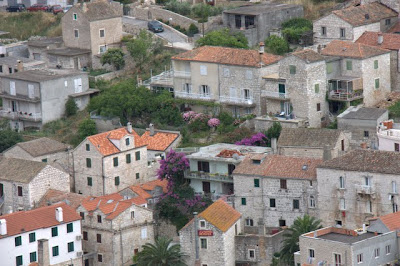



Two: Catamaran from Hvar Town, Hvar Island to Ubli, Lastovo Island
- We took a ferry from Hvar Town to Ubli, the main port on Lastovo Island. From Ubli, you can catch a shuttle bus to Lastovo Town and vice versa.
- Lastovo only has about 800 people total on the island. We knew we had picked a less touristy spot when even most of the Croatians we had met had never been to Lastovo. The island is beautiful, with much of it covered in farmland, mountains or vineyards.
- Although the ferry can take up to five hours from Split to Lastovo, the trip is under two hours if you break it up with a trip to Hvar or Korcula. Plus, there is a fast catamaran (which we took) that reduces the time even further.
- We weren’t sure if there would be Grannies greeting us on Lastovo, so we booked ahead by scouring the Internet. We were right; there was not a single Granny. There is only one hotel on the island. With prices over $100 a night at the hotel, we were glad we found private accommodation in advance. That being said, if you brought a rental car over to the island on the car ferry, it would be pretty easy to find private accommodations by driving up to places labelled konobas and knocking. Many of the konobas have rooms available because they primarily focus on getting sailboats to dock and feeding the sailboat crowds in their restaurants. Without a car, we recommend booking something in advance and arranging for pick up at the ferry dock in Ubli or the bus stop in Lastovo Town.
- It is best not to stay in Ubli (somewhat bland, from what we saw) or Lastovo Town (inland). Without a car, we didn’t get to check out Pasadur, a spot where some rooms can be found. We really liked Zaklopatica Bay, but it is small. The bay is lined with private houses that rent rooms, run small restaurants, and rent dock space to sail boats. Make sure you get a room with a balcony, as the views over the bay are amazing.
- Most (if not all) of the restaurants are not open for breakfast or lunch, so either bring provisions, rent a scooter to ride into Lastovo Town to pick up supplies, or arrange for meals in advance with your host. Other than bring yogurt for breakfast, we did none of those things and almost were caught without lunch. Luckily, the owners of our konoba opened for lunch especially for us.
- Without a car, you are at the mercy of the restaurants in the bay for dinner. Fortunately, all of our meals were tasty (albeit a little pricier than we normally like to spend). We ate at Konoba Santor, where we were staying, as well as Augusta Insula, a popular konoba a few doors down.
- One of the konobas two doors down rented scooters, so we took advantage. Having never driven a scooter before, we ended up wussing out about an hour into the ride and didn’t explore nearly as much of the island as we intended.
- We got the sense that everyone on the island knew everyone else. The island is so small that children live on one of the larger islands or in Split during high school in order to attend school.

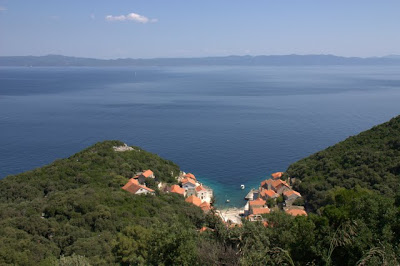

Three: Ferry from Ubli, Lastovo Island, to Vela Luka, Korcula Island
- Korcula is the birthplace of Marco Polo! Many memories of calling out as a kid, Marco! Polo!
- From Vela Luka, we rode a bus through Korcula’s windy roads for about 40 minutes to get to Korcula Town. Again, the buses are timed to coincide with the ferries.
- Although filled with the ever present tourists like Hvar, Korcula Town is smaller and had a better vibe. Many of the bars, cafes and restaurants play music. We especially liked Treseta, a restaurant we stumbled upon one day as we waited for a bus to take us to the beach. The food is great (supposedly homemade by a Croatian granny!) and various people sat and strummed guitars while we ate.

And finally return to the mainland: Ferry from Korcula Town, Korcula Island, to Dubrovnik
The Croatian Grannies
When we were trying to decide where in Europe to go, Croatia kept popping up as a suggestion. Croatia has recently been steadily increasing in popularity as a travel destination for Americans. While just a few years ago, people had lingering concerns about whether Croatia was safe after its war of independence from Yugoslavia in the 1990s (perhaps from watching too many ER episodes about Dr. Kovac), now many wonder whether Croatia is overrun by tour groups and cruise ships. With many seaside cities with quaint stone and marble old towns, a long coastline on the Adriatic sea, and the supposed charm of Italy without the prices, Croatia has seen an influx of travelers in the last decade.
We opted to forgo a guidebook for our time in Croatian (more on that later), and did very little other research into Croatia. So when we showed up in Rovinj, a town picked somewhat randomly because it had a good bus connection from Slovenia, we were surprised to not see many hotels or any pensions (simple, budget accommodations prevalent in Europe). After walking around for a while, our backpacks heavy on our backs, we stopped in a travel agency/money exchange type of place and asked the man working there if he knew of any hotels.
He directed us to what seemed like the only hotel in walking distance from the old town and told us to come back if it was too expensive. Upon learning that the rather simple looking hotel was $160 euros a night – over $200 – we returned and rented a room from the man for $57 euros. The man instructed us to make a couple of turns and look for a house with an elderly woman leaning out of the window. The woman did not speak a word of English. The room we rented was just that – a room on the third floor of the house, grandmotherly décor, and a religious photo over the bed.
At a café with wifi later that night, we did a little more digging and learned that while Croatia has some five star hotels in various cities, the mid-level hotels and budget hostels or pensions have not found their way to Croatia. It has been decades since the fall of communism, so I can only assume there is some reason that I am not aware of that prevents opportunity seeking capitalists to fill this void. (If anyone knows the answer, I’d love to hear it. I couldn’t find a good answer anywhere).
In the meantime, the private residents of Croatia are stepping up to gain some extra income and provide lodging to Croatia’s many tourists. All private rooms must be licensed. The rooms are all different. Some are modern; some are very outdated; all are simple. Some have private ensuite bathrooms; others do not. Some are apartments, with a private entrance; others are simply rooms in someone’s house.
Even after research telling us that private accommodation was the way to go, I still hesitated when we were greeted at our next stop in Pula by an elderly woman with hair growing out of her moles, who was telling us Come with me. My room, it is very cheap. I talked Sean into staying into staying at one of the few hotels in Pula instead. At 96 euros a night (about $121), it was our second most expensive place on this trip so far, and it was nothing to write home about.
The next day, I succumbed to the reality that if we wanted to stay in Croatia, we would have to go with the Grannies. Anyone who travels to Croatia by any form of public transport will meet the Grannies. Many of the Grannies were not actually grannies at all. Some were younger; some were male. But because our first experience was with a woman who was at least 85, they will forever be known as Grannies. At each stop during our ten hour bus ride from Pula to Split, the Grannies swarmed around us, calling out Sobe? Camere? Room? Zimmer? They didn’t always speak anything other than Croatian, but they threw out the name for room in every language. Even telling them that we were just stepping of the bus to go to the bathroom sometimes didn’t stop them from shouting after us. I suppose they thought they might be able to convince us to get off the bus and stay in their town.
While you can book private accommodations in advance from the savvy owners who have set up websites or listed their properties on sites like Hostelbookers, searching for private accommodations this way is very time consuming. We found it was much easier to subject ourselves to the mercy of the Grannies at the bus stations and ferry stops. As long as you were not picky (a very difficult concept for me to grasp), you could be lead directly to a room or apartment by a Granny after finding one where the price was right. The best we could do is try to learn important facts, like how close the apartment or room was to the old town (always, very close, very close – until you press further and find out that very close means a 15 minute bus ride to town).
It was hard to choose a Granny. With the exception of a less populated island we visited, each time we stepped off a bus or a ferry in a new place, the Grannies were waiting. Some Grannies took the approach of shouting at you before you even walked down the ferry ramp.
Other Grannies rushed up to you the second you stepped on land, each of them looking at you with expectant and hopeful eyes. Still other Grannies stood back, and patiently waited for you to come to them.
The savviest Grannies had pictures of their rooms on their signs, like Maria in Hvar Town. Upon stepping off the bus in Korcula, we were drawn to Vela’s sign like a moth to a flame when we spotted the words “Free Wifi” in big black letters. (Internet access was a rare commodity in Croatia’s private accommodations. I was starting to the shakes).
While not all of our private rooms or apartments had private bathrooms, and some of them probably have not been updated in forty or fifty years, all of the rooms or apartments were clean. Some had balconies overlooking the Adriatic Sea, and most were centrally located. They ranged in price from $38 a night to $75 a night. Those willing to spend more could probably find more modern and luxurious private apartments.
Of course, the best part about staying in private accommodation is that we get to know some Croatian people a little bit better, and experience their hospitality. Nada, in Split, recommended a tasty Croatian restaurant for dinner. Vela, on Korcula Island, always stopped to chat when she saw us. When we asked if we could use the outdoor drying rack to hang laundry, she not only said yes, she offered to do a load of laundry for us for free. Valentina, on Lastovo Island, picked us up and dropped us off at the bus stop several miles away. And Maria, on Hvar Island, invited us to her birthday gathering on her patio with her family.
We ate prosciutto and cheese, drank homemade wine from Hvar grapes, and sang Maria happy birthday as she blew out the candles on her cake (which, fortunately for us, but unfortunately for her, was made by her!) While Maria spoke somewhat broken English, we got to chat with her brother and sister, both of whom spoke nearly perfect English. We met Mae and Margaret, two friends from Norway staying at one of Maria’s apartments, who brought homemade Norwegian pancakes and sang Maria a Norwegian birthday song.
For our part, we brought guacamole and salsa, made from ingredients we collected at the island’s farmer’s market. We actually were able to track down tortilla chips at the island’s grocery store, which is no small feat in Europe. The crowd chuckled at our choice of Mexican, given America’s lack of a national food. We explained that as a nation of immigrants, most American foods borrow the best of world – a diversity I rather enjoy. It was funny watching some of the guests try to figure out what to make of the guacamole and salsa. Most ate them off their plates without tortilla chips. Their confusion didn’t prevent them from polishing off both bowls.
All in all, while commodities like beers and food were more expensive than we anticipated for a country who has not adopted the euro, it is not hard to keep costs down by moving around by bus or ferry and by staying with the Grannies.








